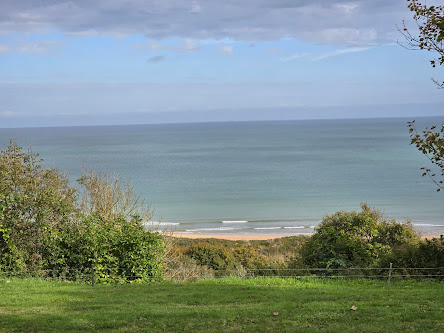Regal Princess/Port of Le Havre, France
Monday, October 7, 2024
Cloud, occasional light rain, 63F
overlooking Omaha Beach
Our Overlord Tours guide, Remy, met us at the dock in Le Havre at 8 a.m., along with 3 other couples, for a day of looking back 80 years to one of the most important days in American history, June 6, 1944. Originally from northern France, Remy has devoted his life to history and the study of World War II. His knowledge and personality made this a very special day.
Omaha Beach is
about 90 miles from Le Havre, an easy drive with good roads today (with some
road work.) We drove through the small
village, Colleville-sur-Mer directly to the beach. The serenity of the scene today
contradicted the horror of that day---grasses were waving in the light wind,
the sea calmly broke quiet waves onto the beach, the sand was almost white. A
few large rocks dotted the scene, and when we turned away from the sea, we
could see remnants of a pillbox and a bunker on the upper banks.
“Bloody Omaha” saw
the highest number of American casualties—3600 wounded and about 770 killed. My mother’s first cousin, Henry Harley
Hall, Jr., of Corry, Pennsylvania, was one of those killed.
“Bloody Omaha” was
the D-Day landing beach that saw the highest number of casualties on D-Day.
Omaha was assaulted by the 1st US Infantry Division, and elements of the U.S. Rangers and 29th Infantry Division. The U.S. suffered 3,600 casualties at Omaha
Beach. Around 770 were killed. As I reflect on the Omaha Beach and
the invasion, it is difficult to imagine the noise, the terror, the willingness
to risk everything.
PFC Henry Hall was 20 years old when he was killed on Omaha Beach. Seven other Erie County men
made the ultimate sacrifice that day, SGT Francis Carnrike of Corry,
killed on Omaha Beach; SGT Joseph Felix of Millcreek, killed on Omaha
Beach; PVT Irwin Hess of Millcreek, killed on Omaha Beach; PFC
William Howard, killed on Omaha Beach; Staff SGT Leo Ferretti of
Erie, killed on Utah Beach; Staff SGT Charles Kettering of Corry, killed
at Point du Hoc; and PVT Harold Innes
of Corry, killed in 101st Paratroop Division drop. These men are honored on the World War II
Memorial in Erie County Veterans Memorial Park, Erie, Pennsylvania.
After quiet time
on the Beach, Remy drove us to the Normandy American Cemetery nearby—the 172.5
acres contains the graves of 9,389 of our military dead, most of whom lost their
lives in the D-Day Landings and ensuing operations. This peaceful cemetery is reminiscent of the
American World War I cemeteries in France that TK and I visited in 2015 and 2018, perfectly
maintained white marble crosses or Star of David symbols in rows and rows. One of the Superintendents of a World War I cemetery
in 2018 told us to look at the gravestones as men and women standing before us.
Today, 9,385 men and 4 women stood before us---those who sacrificed their lives
in the name of freedom.
Bayeux, a city
liberated on June 7, 1944, is known for the famed 223 foot long Tapisserie de
Bayeux, an 11th-century tapestry depicting the 1066 Norman invasion of England,
on display in an 18th-century seminary.
I was sorry there was not time to see it, a thousand years old! I did
visit the gift shop, but I would love to return one day. I have heard of this treasure since high
school and art history classes in college.
Finally, we made a
quick stop in Honfleur, giving me enough time to take photos of those narrow houses
again in another attempt to explain how those narrow houses are built!
We did make it back
to the ship for dinner. After dinner as we were back in our room, the Captain
announced what we were expecting. Because
of Hurricane Kirk, we will not be going to either port in Spain on Wednesday
and Friday, Bilbao and Vigo. The hurricane
over the Atlantic now is heading straight to Spain. The Captain also mentioned we would be
heading back to Cobh, Ireland to port on Wednesday. Then we will head to Madeira,
Azores Islands after that. He mentioned another storm, Hurricane Milton –he does
not yet know how it could affect this sail.
We are thinking
more about the impact on the U.S. and our family and friends in Florida and other
areas that are under duress. We are going
to be fine.
TK’s Takes: Round Abouts are prevalent, but not for 3
streets or roads converging like on Route 5 west of Erie. Roads were good.





.jpg)










The cemeteries are humbling to say the least makes you realize how small we are and the sacrifices made by the greatest generation. Milton is so close now. It is a "killer", be safe...
ReplyDeleteWhat a profound experience. Hard to believe so much bloodshed among such beauty.
ReplyDelete